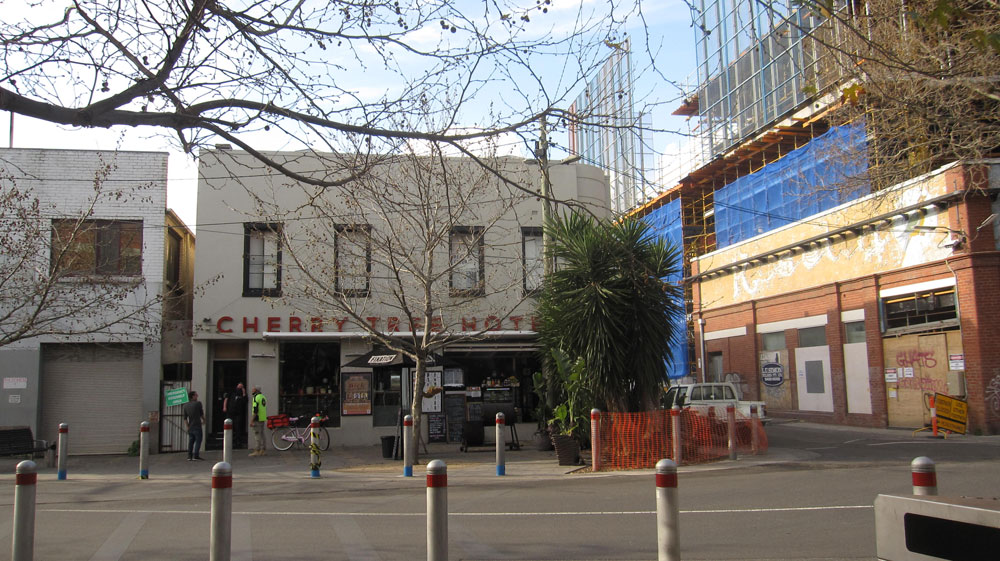Part 1. -Sir Henry Barkly Hotel
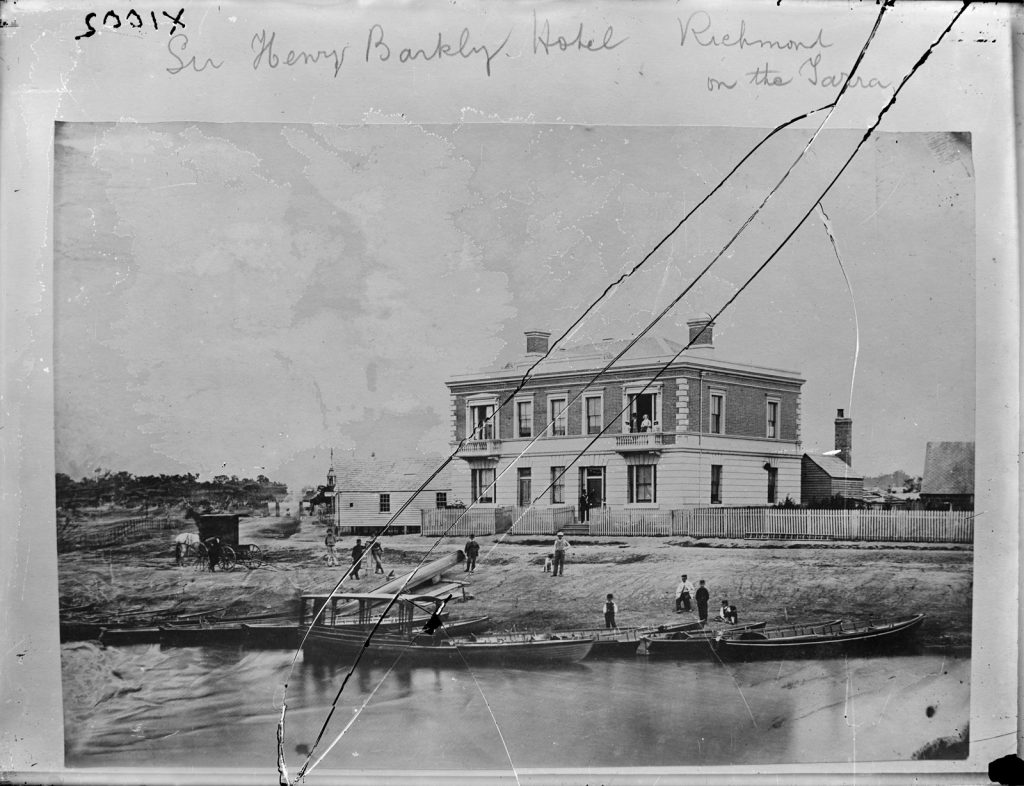
Once upon a time there was no freeway that blocked access to the river and there was no Hoddle bridge that connected Punt Rd to Sth Yarra. The Sir Henry Barkly Hotel sat at the end of Punt Rd where the punt would take you across the river. It was the home of the Richmond Rowing Club before they relocated to their current digs near Princes Bridge. The hotel site later became the Riverside Inn before it was demolished to make way for the expanded freeway ramp.
This once lively and social riverside part of Cremorne is now a concrete cavern beneath a freeway overpass. It is a difficult to access space that at least provides a link to the Yarra Trail. Could something better be done here for the community? The developments at the Malting site provides some opportunity and there have been several recent examples of possibilities beneath Skyrail sites.
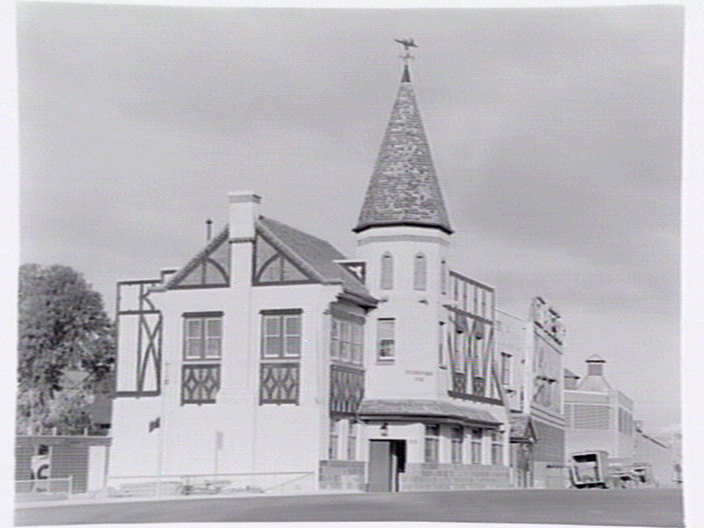
Part 2. Station Hotel
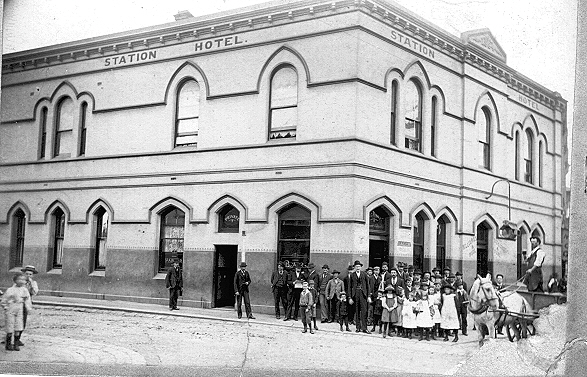
The Station Hotel was so named because it was opposite the entrance to Richmond Station on Swan St, though the railway station was in a different position to where it is now. The hotel was on the corner of Swan and Dover St. when those to streets met. When Richmond station was redeveloped in 1959, the entry was placed further toward Punt Rd and the railway bridge was expanded to add extra tracks. This engulfed the pub and several shops along side.
The Station Hotel was built around 1884. There was an earlier pub around the same site called the Dove Hotel. Presumably Dove St was named after the pub just as Swan street was named after its namesake hotel.
On street names – Dover St was once called Barney St but had a name change around 1860 when the Cremorne Gardens was still operating. Apparently Barney St had developed such a disreputable reputation related to certain activities associated with Pleasure Gardens that it had to be cleansed of its name.
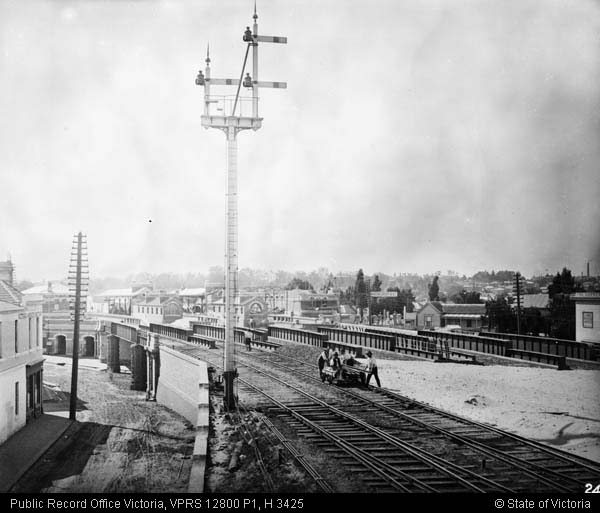
Looking toward the old Richmond Station from where Stephenson St used to be. Railway land has a huge presence in Cremorne. Apart from lines creating barriers to movement, there is plenty of real estate alongside that is owned by Vic Track. Much of this is used as car parking while there are chunks of land that do not seem to be doing much at all. Considering there is such a dearth of green space in Cremorne, this public land could be looked at creatively to be more be more beneficial to the Cremorne Community.
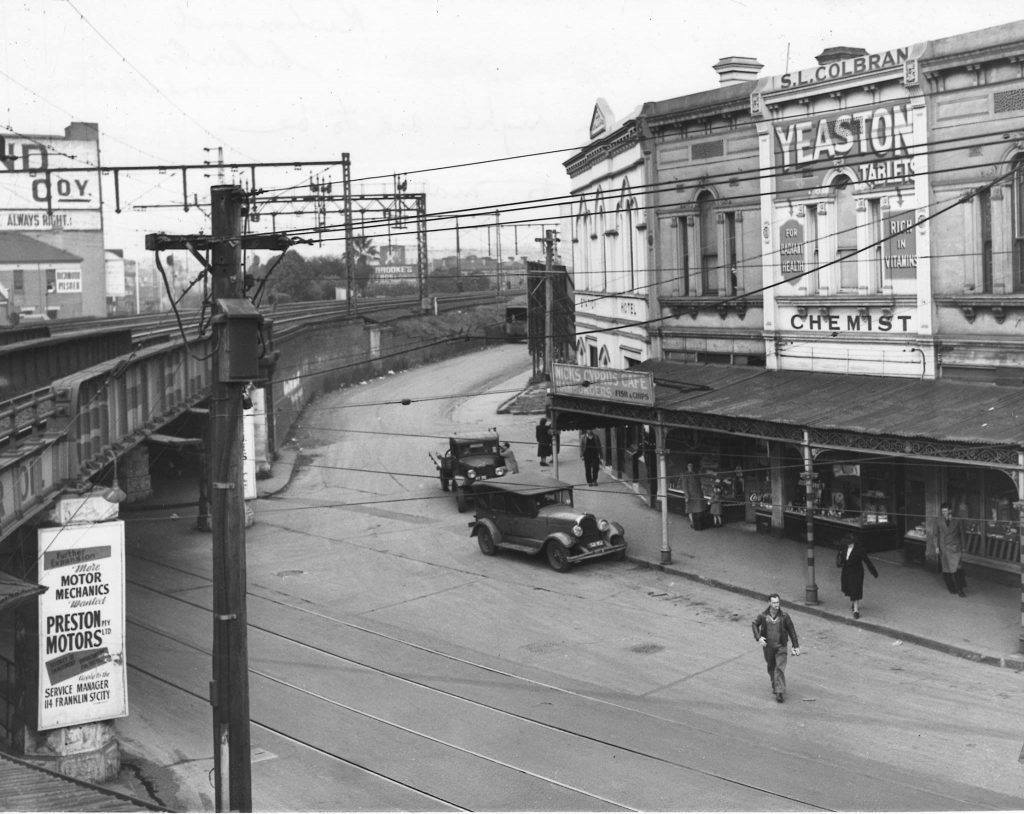
A different perspective looking down from the old station toward Stephenson St. Date about 1948. The Station Hotel is on the corner next to Nick’s Cyprus Cafe. This whole scene is now beneath the existing rail bridge.
Part 3 Village Belle Hotel
15 Cubitt St.

It’s difficult to imagine this scene in Cubitt St now, but the Village Belle was first licensed around 1880 and lived nestled among residential cottages, with a malt house behind it in Gwynne St. Prior to this time there was an earlier pub called the New Cremorne Hotel on the same or similar site. Down the Rd on the corner of Kelso St was the Red Lion Hotel. Both pubs fell prey in 1917 to the Victorian delicensing Board, along with many other pubs in a wave of temperance sentiment at the time. As the drawing suggests there was a bit of green space around the hotel itself, which is confirmed in the old 1896 MMBW map. Ironically, the Red Lion site is now a space, though reserved for car parking.
Cubitt St was also where the great Tommy Hafey spent part of his time growing up. Being a teetotaler, he wouldn’t have missed the nearby pubs, though he would have appreciated some green open space to do his pushups. Wouldn’t it be nice to have a green space that is not reserved for cars, for some healthy physical recreation that we can dedicate to Tommy? – and maybe for a quiet beer as well?
Part 4. Grand Crystal Bar –Cremorne Gardens
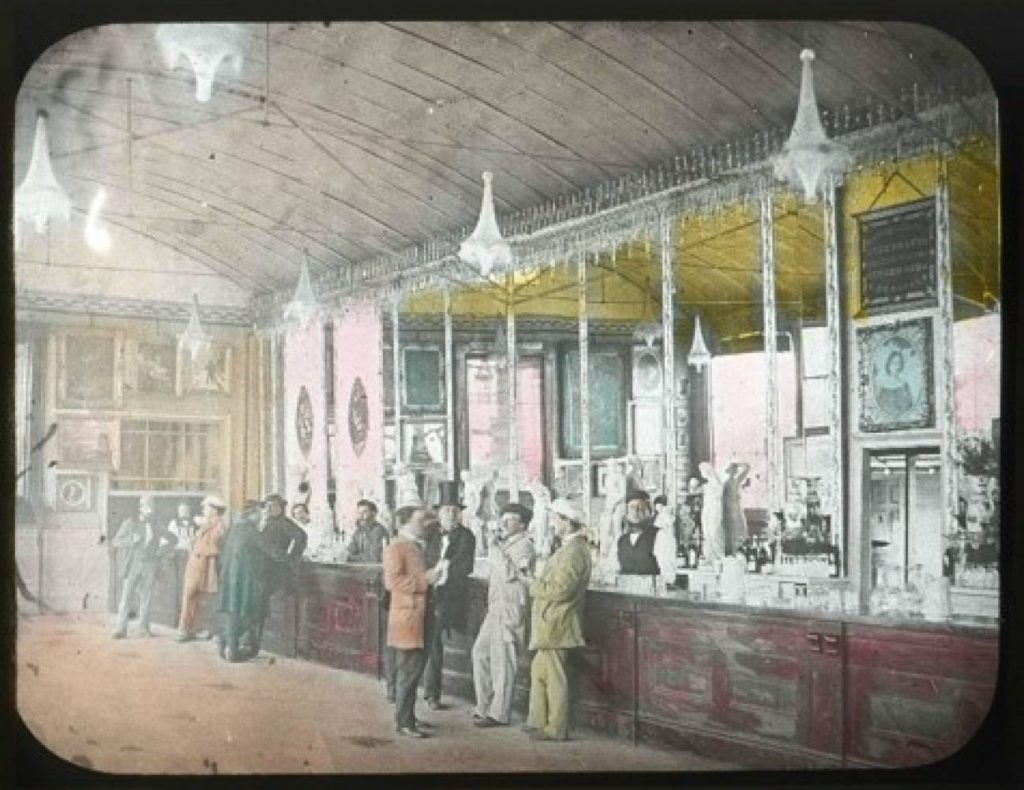
The 1850s was a boom time in Melbourne and the Cremorne Pleasure Gardens were established to cater to that boom. A big influx of population seeking their fortune were also in need of entertainment and sanctuary.
The Cremorne Gardens provided such an assortment of delights in salubrious, cultivated surroundings. Drinking was just one aspect of it. There were two drinking establishments within the gardens. One was Mrs. Peachman’s Hotel, situated just within the river entrance at the bottom of Cremorne St, where you’d be deposited by gondola from Princes Bridge. The other was George Coppin’s Crystal bar which was situated near the Balmain St entrance opposite the Cherry Tree. George appreciated the benefits of beautiful green open air spaces in a boom town to make people feel happy. He is the guy with the top hat in the image.
A review of the Crystal Bar from .The Argus 1858:
“…it is one of the handsomest places of the kind we have ever witnessed. An air of coolness and increased spaciousness has been given it by the erection of a wall of plate-glass in the rear of the counter. At the top of the mirrors at the back of pendant crystals are the jets of light which illuminate the place. Statues and flowers vases and pictures, are deposited wherever there is a chance of heightening the general effect. Altogether, as an exhibition of taste devoted to a special purpose, we imagine the bar may challenge competition with anything of the kind in either hemisphere. In our own country this style of drinking is rarely attempted. It is in America where they are found in the greatest perfection, and we therefore must leave it to our trans-Atlantic brethren to decide upon the comparative merits of this Bacchanalian resort.”
Part 4. Yarra Hotel
119 Cremorne St
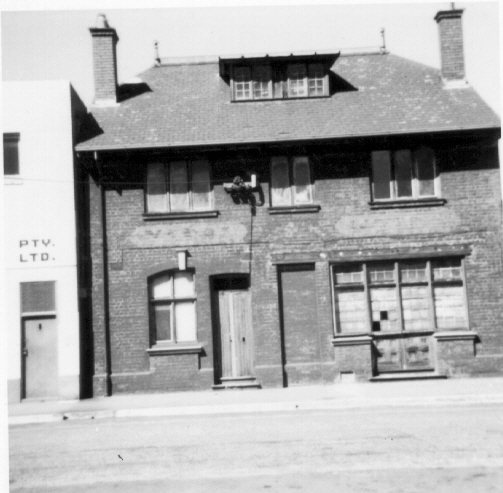
Matthew Dwyer obtained his license for the Yarra Hotel in 1854. It was one of seventeen Richmond pubs operating that year, whereas just a few years before it was considered two licensed premises were enough. Melbourne was booming. One of those two was the Richmond Hotel that sat down the road on the corner of Balmain St, while the Beehive came along up the road about ten years later, just north of Blanche St. The Yarra out lived them both lasting to the ‘big delicensing’ of Melbourne pubs in 1917. The existing building replaced an earlier one in 1909. It spent most of the 20th century as home to a rubber goods manufacturer, before being nicely restored as a residence.
Then as now, boom times in the neighbourhood can be accompanied by dangerous neglect. The Argus in 1868 bemoans the state of street access at the bottom end of Cremorne St. It accuses the council not acknowledging responsibility for the street following fatal accidents on the Yarra bank:
“What did it matter if an occasional wood-carter or cabman’, or a couple of children, were precipitated into the river from the break-neck bank.”
“Between the Sir Henry Barkly Hotel and the extremity of Cremorne-street, there is a “lagoon” or, more correctly, an extensive cesspool, which is constantly fed by liquid stuff running from Mitchell’s brewery. This quagmire is very insufficiently protected, ……. If a horse were to bolt near this spot he would be compelled either to take the river, or plunge to the saddle-girths in sludge”
The cesspools have been cleared up in Cremorne St., but so have the pedestrian crossings that until recently provided some protection from ever increasing traffic in boomtown Cremorne. Hopefully the council this time will acknowledge its responsibility of keeping this street safe.
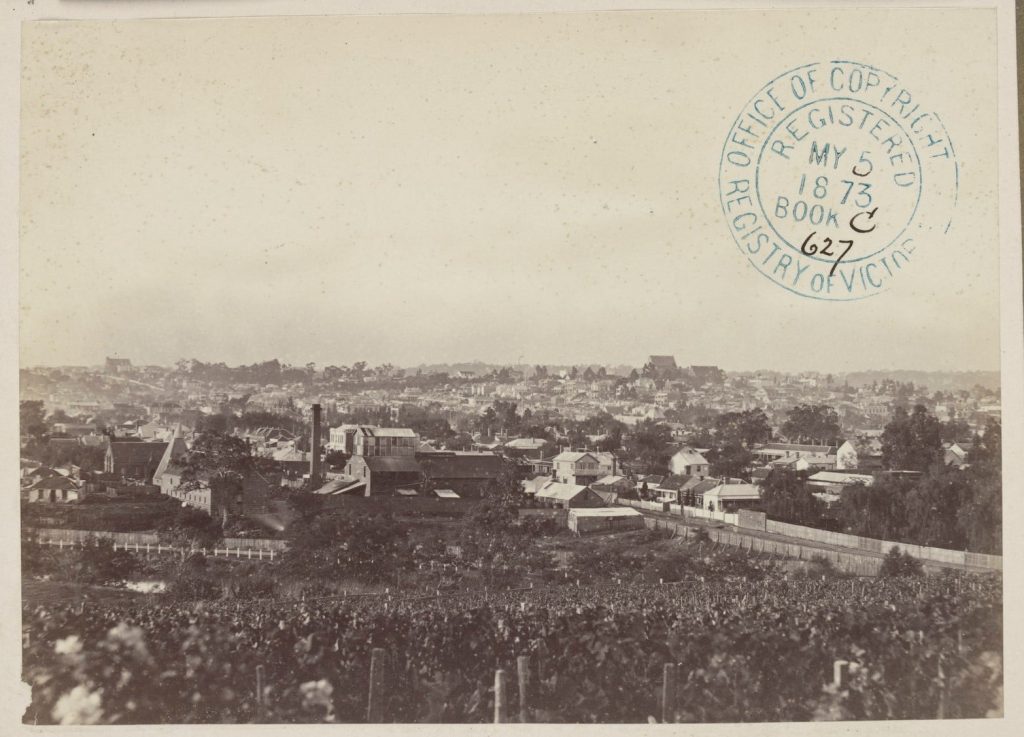
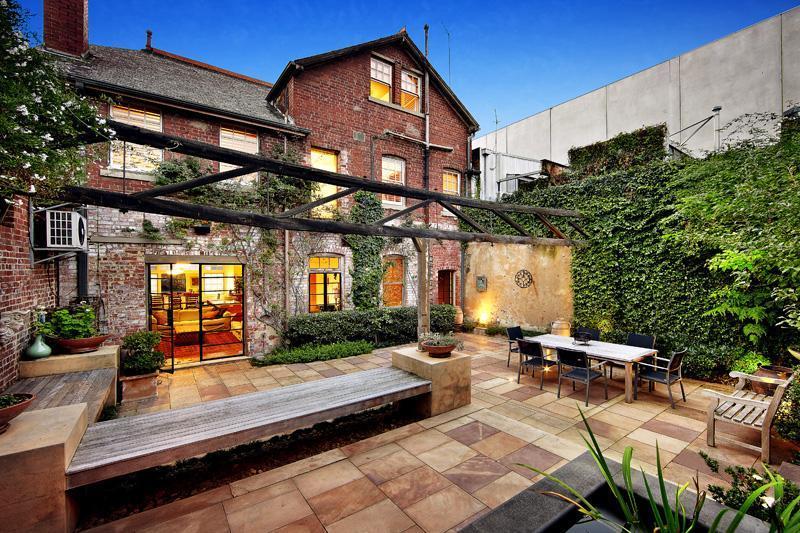

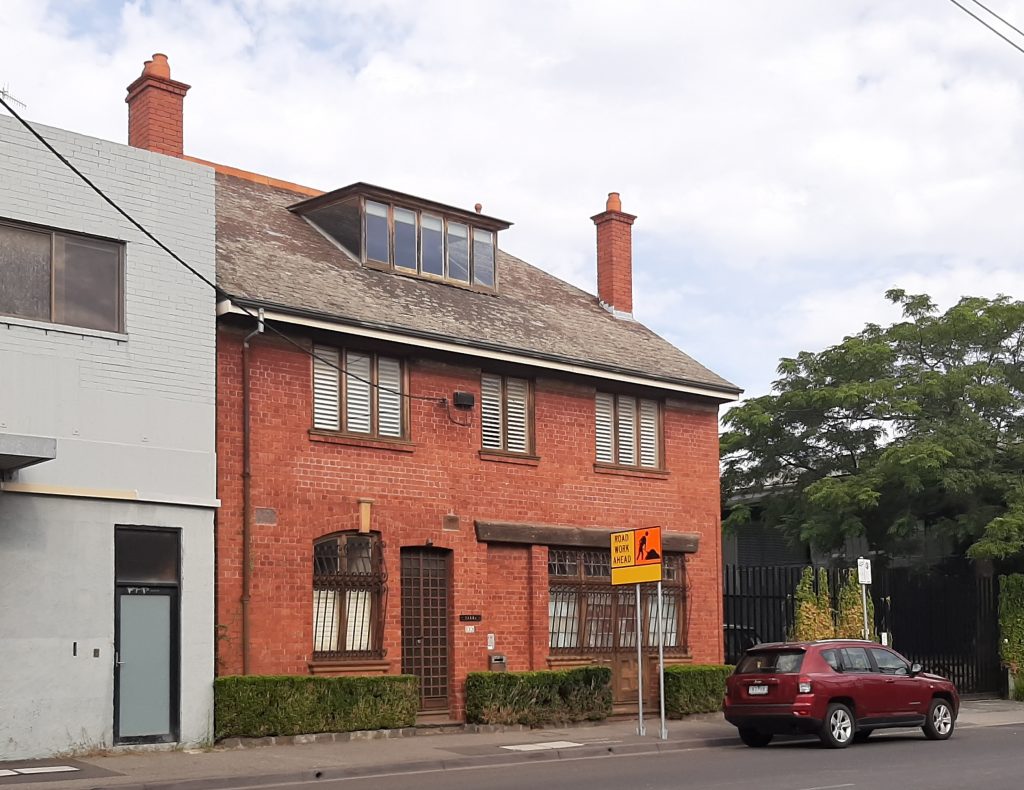
Part 6. Freemasons Tavern
5 Wellington St.
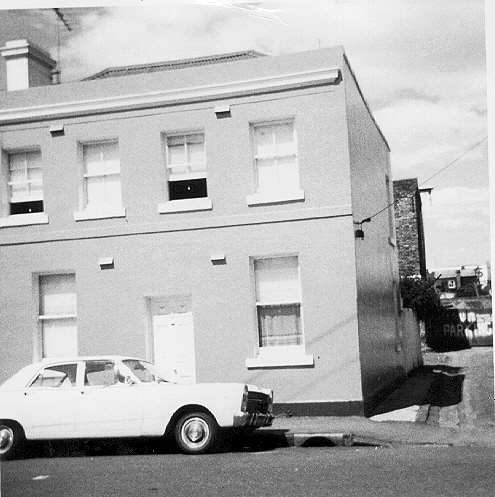
Born in1865, the Freemasons Tavern lasted as a pub till the licencing court removed its licence in 1884. The court described it as a “house containing only six small rooms and being in a very bad condition. It never ought to have been licenced.”
Just prior, nearby on Punt Rd, was the Wellington Hotel. Perhaps another case of a street being named after a pub? It existed from about 1853 and lasted till around 1862 having then become the Red Lion.
After the loss of its licence, the Freemasons Tavern spent some time as John Webb’s ‘Tabernacle Ragged School Relief Mission and Night Shelter’ before it found a more purpose built premises in Cremorne St. An earlier ‘Hornbrook Ragged School’ also existed around the corner in Little Cremorne St (now Jessie St).
There were other early schools and community services in Cremorne. When the Cremorne St Primary school opened in 1878, it was next door to a ‘Scripture Free School’ which was operating from a ‘Wesleyan Chapel’. This caused a bit of early friction that reached as far as state parliament. Apparently the state school head master was accused of manipulating bell times to disrupt religious discussion and declaring to students that they had no souls.
The chapel also became meeting place of a lodge of the ‘International Order of Good Templars’ as well as the ‘Hope of Cremorne Juvenile Temple’.
St Stanislaus catholic infant school, until the late 1980s occupied the stretch of Balmain St between Cubitt and Dover Streets. A site that had earlier been part of Mr Harcourt’s ‘Asylum for Lunatics and Inebriates’, which succeeded the Cremorne Gardens.
The old state primary school buildings is about all that remains of these institutions. Now absorbed by Kangan Institute, the site is a significant presence in Cremorne. Could it be better utilised as a community asset as part of its educational charter?
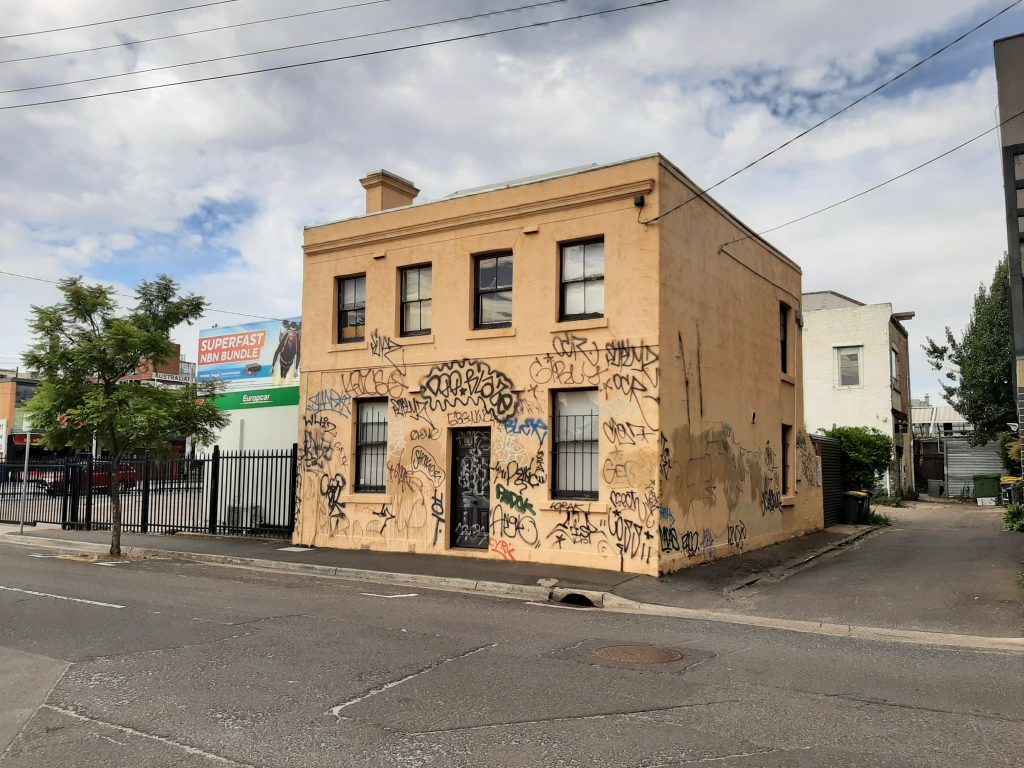
Part 7. Bowling Club
36 to 38 Swan Street
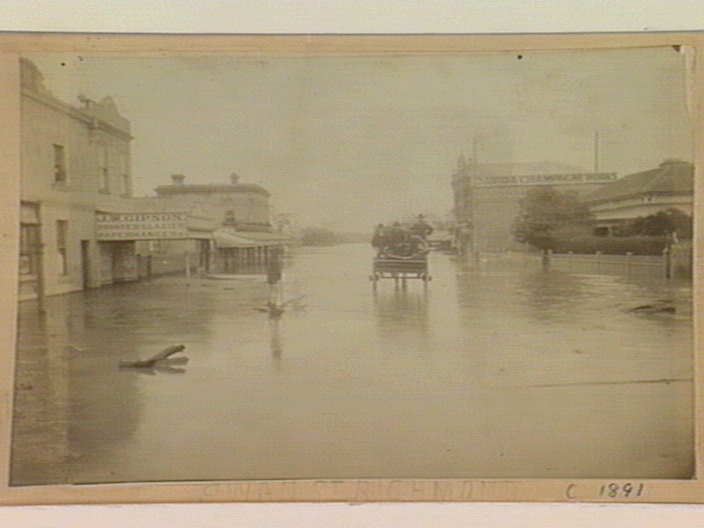
In 1865, in the west end of Swan St, Mary Smith became the publican of the newly established Daniel O’Connell Hotel. By 1876 Mary had died and the next year the pub’s licence was refused on the grounds ‘that larrikins were allowed to frequent the place and play cards’.
The pub still hung on with a succession of owners to 1884, when it had rebadged itself as the Bowling Club Hotel. Was there an actual bowling club nearby? There appears to have been a bowling green at the bottom of Lennox St for a while in the 1870s. There were also bowlers that would gather in Yarra Park on the corner of Swan St. and Punt Rd around the time.

Whatever it’s naming inspiration, it was the focus of the early commercial development of Swan St. However, The Bowling Club was yet another that met its demise in 1917 when it lost its licence. The building has remained over the decades since. More recently, it has been as a born again pub badged as Holliava.
In this 1891 image of Swan Street, looking west, the Bowling Club Hotel is on the far left. The picture was taken during the ‘Great Flood’ that year. It was reported then that Cubitt, Dover, Cremorne and Wellington Streets were completely inundated. Families were removed and temporarily lodged in the Cremorne St State School.
The houses and industry south of Balmain Street, that had been the site of the Cremorne Gardens was particularly affected. This was already known to be below the flood water mark after major floods in1863. An early example of the importance of some sustainable and appropriate development in Cremorne.
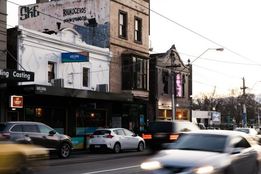
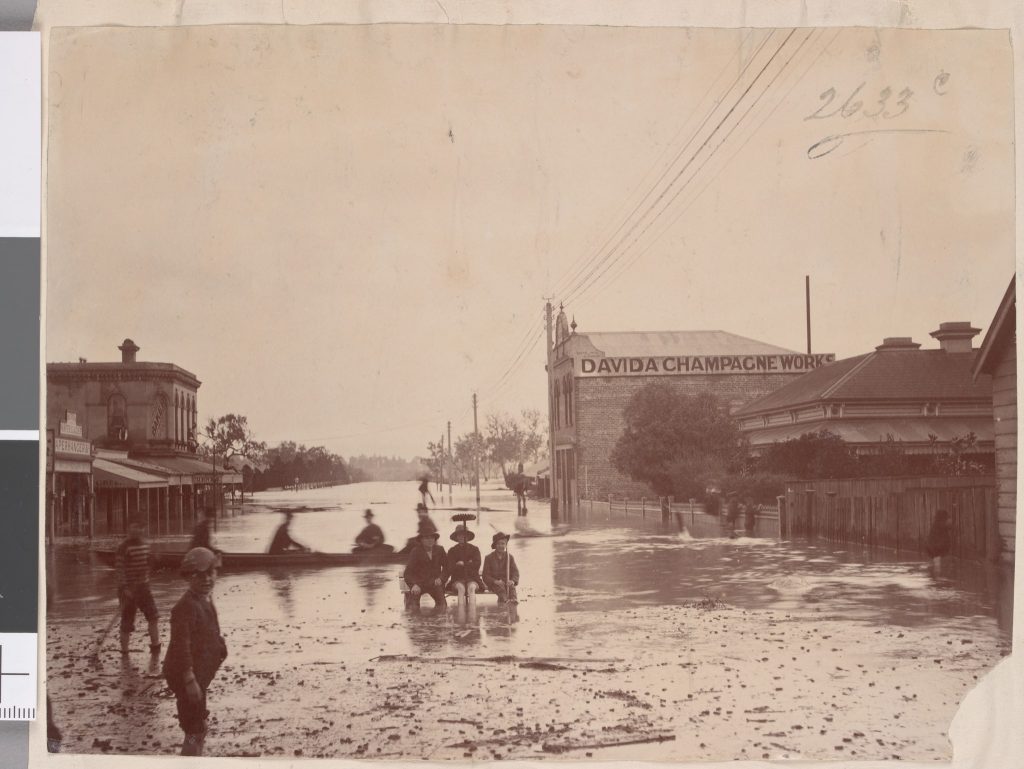
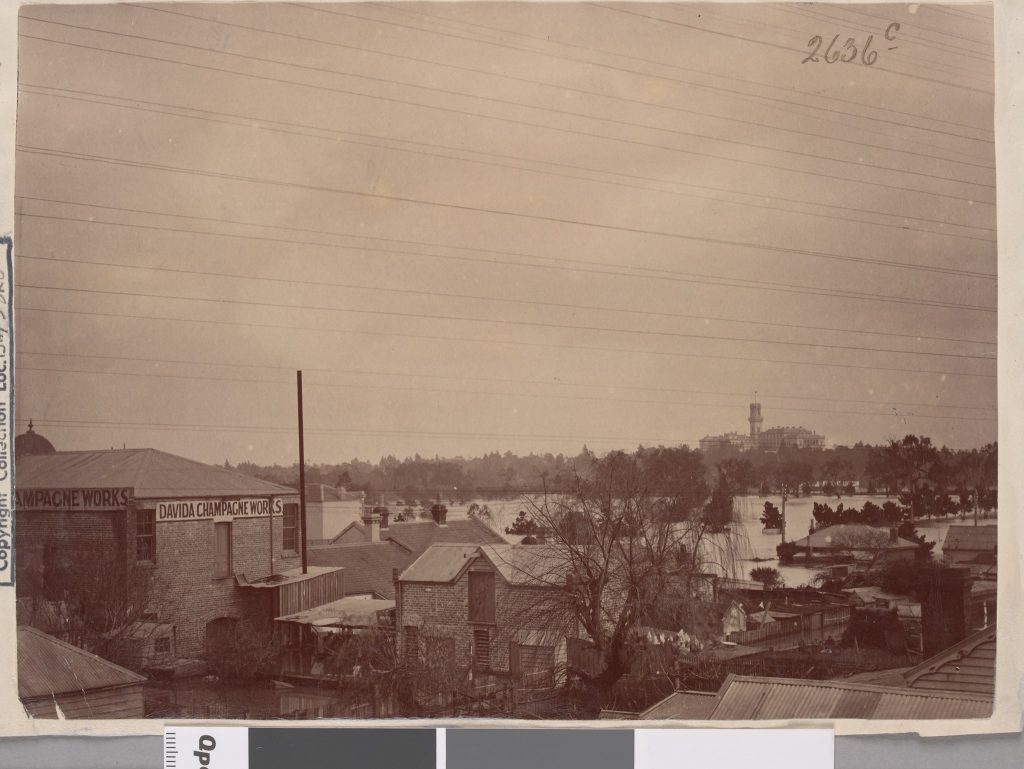
Part 8. Bricklayers Arms
484 Church St.

The Bricklayers Arms first appeared on the corner of Pearson St about 1862 and finished as a pub in 1923, by which time it had become the South Richmond Hotel. It briefly had a near neighbour in Church Street on the other side of the railway line, called the Britannia Hotel. That pub existed for just a few years around 1870.
This is an image of Church St looking south, about 1878. The Swan Hotel can be seen on the left, while it would appear that barrels are being unloaded outside the Great Britain Hotel. The Bricklayers Arms is a little further on the Cremorne side. At the far end of the street is The Prince Alfred which had just changed its name from the Prince Patrick Hotel. The actual Prince Alfred had visited to extraordinary local interest in1868. An attempted assassination by an aggrieved Irishman prompted a great wave of sympathy which led to a mass naming of hospitals, streets, parks…and pubs after the Prince. It didn’t help the Prince Patrick that most of the ire was directed at Irish Catholics who were most antagonistic to the Prince and his visit, so a name switch from Patrick to Alfred must have seemed apt.
Those early days of the rapidly developing Richmond were reflected in the names of the pubs. Not only were the local bricklayers acknowledged, but across the road at the same time was the Quarryman’s Arms Hotel, which was to later become the Great Britain.
Similarly, the Gardener’s Arms in Brighton St, Blacksmiths Arms in Bridge Road, Builders Arms in Rowena Pde, Foresters Arms in Victoria St, Tanners and Curriers in River St and of course the Cricketers in Punt Rd all give us an idea of what people were busy doing locally.
With Cremorne now undergoing another bout of rapid development, perhaps some of the associated ‘food and drink premises’ could also reflect the local industry. Digital Designer’s Arms, maybe?
Part 9. Duke of Richmond
100 Swan St
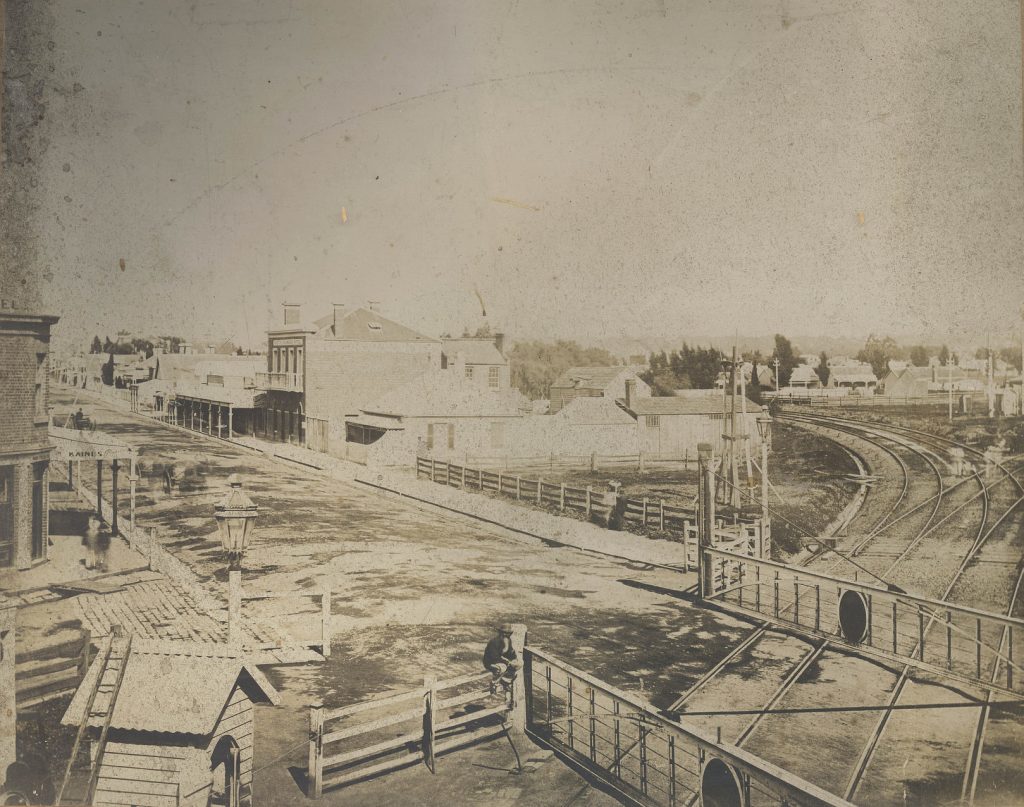
The Duke of Richmond Hotel appeared at the base of Lennox St round 1862. Twenty years later, it became the Richmond Club Hotel, as we know it today.
This is a view of Swan Street, looking south-east from the railway crossing in about 1870. The initial two storey pub building can be seen across the road. The vacant land in the mid ground is where the ‘Posty’ now stands. On the corner on the left hand side would be the original Corner Hotel, which would have been newly built at this time.
The Richmond Club Hotel was rebuilt in1927 ‘in accordance with the latest ideas in hotel development’ with its ‘classic columns and ornamental balustrading’ according to the Herald in the day. The Corner Hotel was rebuilt in the sixties once the railway overpass was further extended.
In the 1870s, the railway was run by Melbourne and Hobson’s Bay Railway Company, with one line going to Hawthorn and the other making it to Windsor. The state would take over the growing rail system in1878.
The Victorian railways got to claim a decent allocation of Cremorne real estate from very early on. In the ensuing decades the value of every small patch of land here has increased significantly in such a congested urban precinct. As we try to find small patches of turf to turn into ‘parklets’ to address the dearth of public green space, VicTrack sits on land that lies fallow. As a publicly owned entity, perhaps VicTrack could come to the party and be part of the Cremorne community.

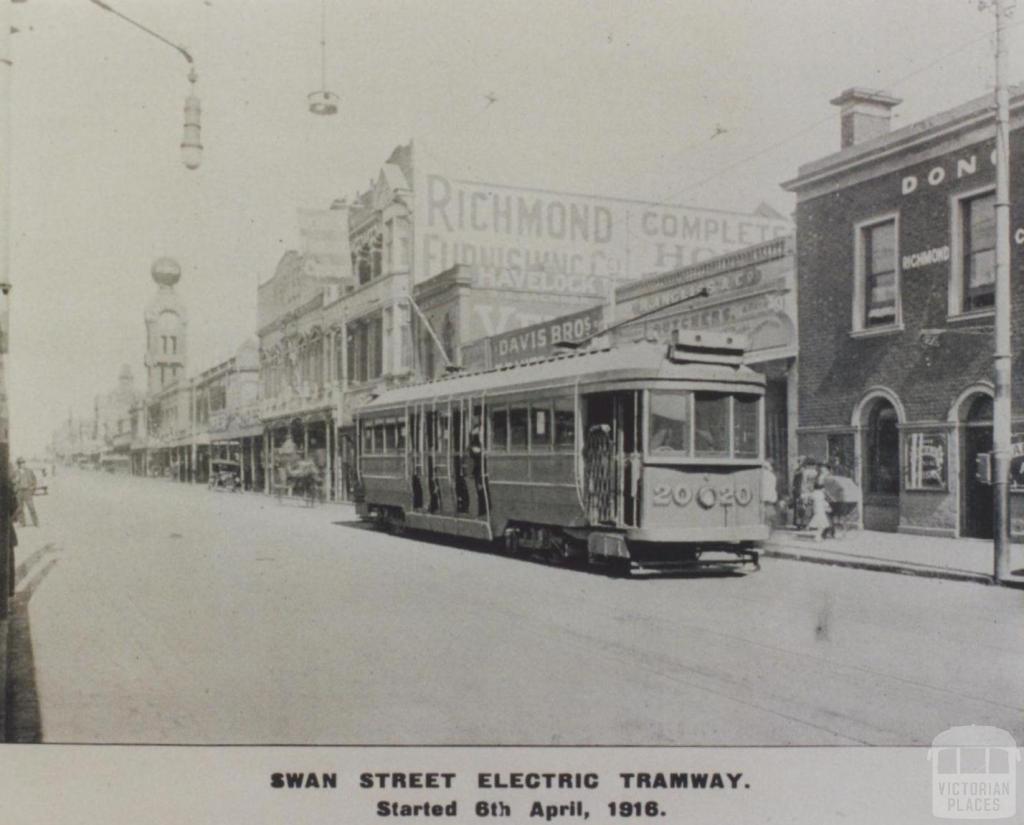

Part 10. The Greyhound
60 Swan St.
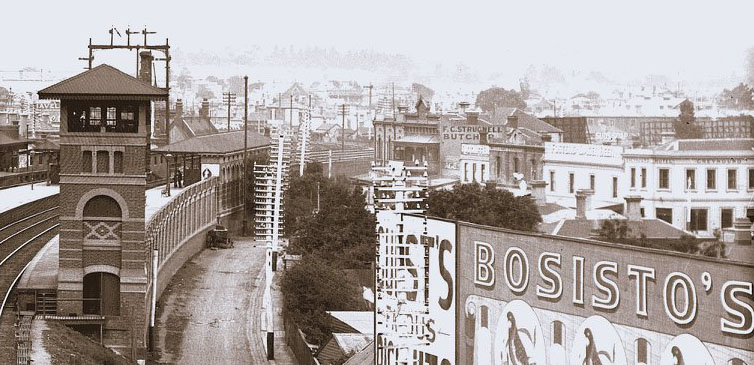
The Greyhound was one of Richmond’s very early pubs, established in the early 1850s. The current building is much younger, built in 1926, as proclaimed on its facade.
Since the 1980s it has had a series of name and character changes. It became Bensons Tavern and then the Depot before settling on The Precinct, as it is now.
The pub has had quite a history of being run by footballers; Royce Hart and Craig McKellar while it was still the Greyhound. Peter Daicos had it as Bensons. Dave and Luke Darcy have since turned it into the Precinct.
From 1942 for about twenty years, The Greyhound was run by the legendary Frank “Checker” Hughes who had won premierships as coach at Richmond and Melbourne.
In September 1942 the pub was the target of arson. As the Age at the time reported:
“a terrific explosion was heard…… followed by the crash of glass from shattered doors and windows, and the wrenching of metal sheets from the underside, of. portion of the verahdah……..,the police found that the double door leading to the bar on the Cremorne-street frontage had been practically blown out, and a bar partition, with extensive glass panels, wrecked………….A curious ‘ feature was that, with the exception of a bottle of schnapps and a bottle of wine, which over turned, and two bottles of : ginger ale which were broken, the bar stock, inoluding pots,” glasses, &c., was not affected by the concussion……The police believe that the explosion was caused by a plug of gelignite, to which a detonator and fuse had been; attached. ‘
This is an image of the old Richmond station in 1910, looking south. The Greyhound is seen on the far right of the shot along with the row of Swan St shops that used to be there before the railway lines expanded.
The Corner of Cremorne and Swan Streets has been a magnet for much of Melbourne for decades. Thousands of people funnel in for the sports and entertainment, the pubs and the restaurants, for work and commerce. The Greyhound in its various guises has been the constant pivot for about 170years. Sadly this great entry point is a dangerous confluence of pedestrians, road traffic and trams surrounded by shabby and inaccessible car yards that happen to be owned by the Department of Transport. Perhaps our public authorities could make this a safe and attractive ‘Precinct’ that people would enjoy arriving to.
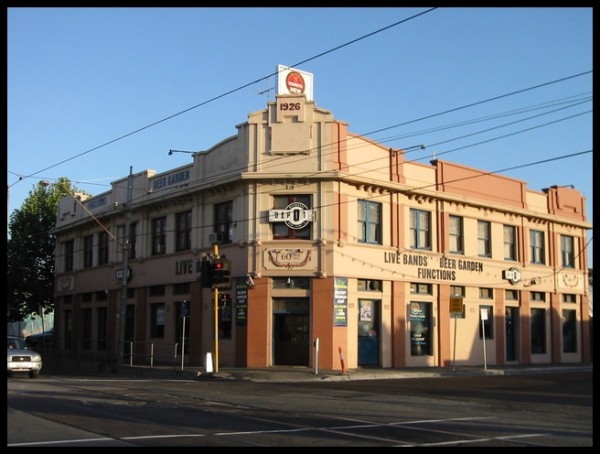
Part 11. Cherry Tree Hotel
53 Balmain St
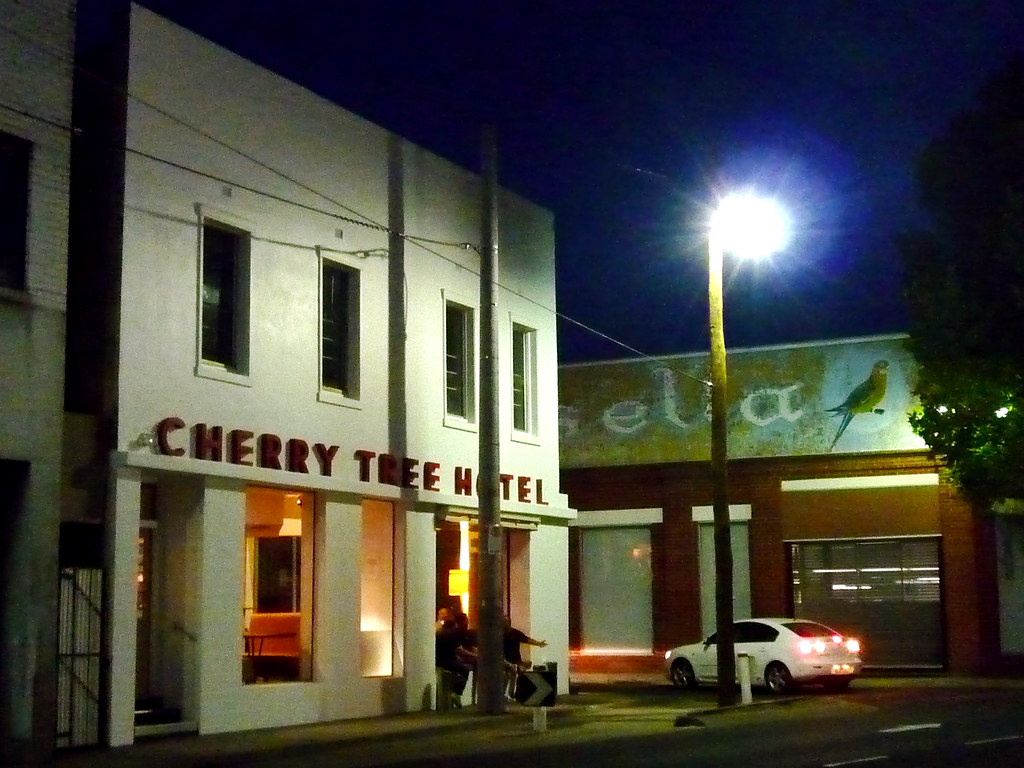
For over 160 years, The Cherry Tree Hotel has stood as the surviving constant; a social heart of Cremorne as it continues to be today. It has seen some physical changes – a rebuild between the wars and a dramatic refit in the 1990s.
When the Cherry Tree started operating, around 1860, the Cremorne Gardens had already been operating for six years. So the area was probably something of a magnet for people looking for fun and festivity.
At about the same time George Coppin contrived to have a railway line from Richmond to Winsor with a Cremorne station across the road from the pub.
Apart from the drinking houses in the Pleasure Gardens themselves, there were a few other pubs in the near vicinity: the Richmond, Yarra, Sir Henry Barkly, and Red Lion Hotels.
The 1850s goldrush was a big decade for pubs. The 1860s however, couldn’t maintain the patronage of drinkers and fun seekers to the neighbourhood and so the Cremorne Gardens ceased in 1863.
While South Richmond/Cremorne was a rich neighbourhood in social terms, it was never so in economic terms. Most of it was built up with workers cottages in the 1880s but the locals were badly hit by the 1890s depression. Though while the rest of Richmond also struggled in the depression years, South Richmond was in a constant state of relative deprivation.
‘Then we shifted to Dover Street, South Richmond, down among the thugs. That was near Rosella, and that and Bryant and May were the main employers of labour. She was a poor suburb too. They fought a lot. But I never seen anyone die of starvation like they did in the depression. A lot of people committed suicide in the depression.
But how they lived…some of them got married and never had a job. There were 400 kids in two streets, Gwynne Street and Cubitt Street, little terraced houses, and every family had four and five and six kids. There were four hundred kids and I don’t think we had a pair of boots between the lot of us. I went bare-footed till I was about 13 because we couldn’t afford boots.
Arthur Dunlop, born 1911 ‘Copping it Sweet – Shared Memories of Richmond’ 1988.
The Cherry Tree remained the epicentre of a community that needed to be resourceful, though not always legally. Crime was a common consequence of poverty:
‘We’d raid the fruit carts when they came to Rosella. We had a fine art. … we’d rip out the back of the cart. The women’d rush out with their knives and split the bags open put their aprons underneath. Oh yes, that was a tough locality! But you had to do that to survive.’
Arthur Dunlop, born 1911 ‘Copping it Sweet – Shared Memories of Richmond’ 1988.
Rampant unemployment resulted in disaffected youngsters that banded in gangs or ‘pushes’. One notorious one was the ‘Irishtown Push’ that operated around Church Street, menacing people near the bridge. Another was ‘The Balmains’ –
‘There were anything up to a hundred in that mob, but we used to follow the fights when the clashes were on. On Saturday night, outside the Rosella door, where the Cherry Tree Hotel is, at four o’clock there’d be a two man fight, and at six o’clock there’d be all-in brawl.
I seen a bloke with a shotgun one Saturday evening and he blew half his face clean off. That was a bit of a gang fight.’
Arthur Dunlop, born 1911 ‘Copping it Sweet – Shared Memories of Richmond’ 1988.
The notorious Martha Needle was a near neighbour to the Cherry Tree, living with her husband and three girls on the NW corner of Cubitt and Balmain. Over a period of six years from 1885 she murdered each one of the with rat poison. Martha was hanged 1894.
In 1908 a twenty year old Squizzy Taylor ‘was convicted of stealing ten shillings from the till of the still flourishing Cherry Tree Hotel in Balmain Street and was sent to gaol without option of a fine for giving cheek to the bench.’ (Janet McCalman, Struggletown)
As the twentieth century progressed, other pubs disappeared, along with churches, shops, schools and other community facilities. Post World War 2, there was a particular replacement of the old cottages with industry and commerce. While this helped with local employment opportunities it was also an effective ‘slum clearance’.
The Cherry Tree had another brush with high crime in 1954 when Johnny Willoughby was shot dead outside the pub in a dispute with an SP bookie.
Dennis ‘Mr Death’ Allen and the associated Pettingill/Pierce clan is the most recent high profile hoodlum link with the Cherry Tree. Through the 1980s Allen rapidly built a drug fuelled crime empire, based around the corner from the pub. While he progressively collected Cremorne real estate, he was murdering friends and associates and chain sawing their body parts. He managed to play off different members of the police force who were either trying to nail him for his crimes or using him as an informant on his ‘friends’.
He treated the Cherry Tree as his Manor. The well known sports journalist, Scott Palmer on acquiring the pub with Ron Barassi and Adrian Gallagher, had the unenviable task of informing Allen that he couldn’t store his guns there any longer.
Fortunately for Scott and future Cherry Tree operators, Allen died of a rare heart disease before he could serve any time. It was about this time that this part of South Richmond officially became known as Cremorne in1990.
By now the demographics had changed. The gentrification of the inner Melbourne suburbs was seeping into Cremorne. Young professionals and ‘creatives’ were moving in while manufacturing was moving out. A funky eclectic vibe was emerging from the lawlessness of the hard end of Struggletown. The Cherry Tree had reinvented itself and became a destination that drew queues of young pub goers along Balmain St looking for the latest venue.
Now Cremorne is getting noticed, outside of unsavoury crime stories. Investors in large commercial and residential developments are changing the nature of the neighbourhood again. Depending on your perspective, this change might be for good or evil. It will certainly be for the worse if any sense of community is lost. Allowing opportunities to connect and share are crucial for a healthy neighbourhood.
‘Dover Street in the 1920s was a street of houses and people. For most of the children it was the whole world. In a way it was a village life, a village bounded by Swan and Church Streets, the Yarra and the park on the west side of Punt Road. Dover Street was foot races, rounders, cricket in the streets, racing around the block, spinning tops, cherry bobs and alleys.’
Jim Jack, (born 1916) ‘Copping it Sweet – Shared Memories of Richmond’ 1988
2020s Cremorne is quite a different place to 1920s South Richmond and may never go back to being overun with inhabitants racing around the block. Since 2015, however the Cherry Tree Hotel has introduced a New Chapter to Balmain Street and is doing its best to promote some village life.
As new players with big invested interests join the neighbourhood, we might urge them to contribute their own bit of neighbourly spirit and make their arrival a welcome one. Perhaps some spinning tops, cherry bobs and alleys would help?
